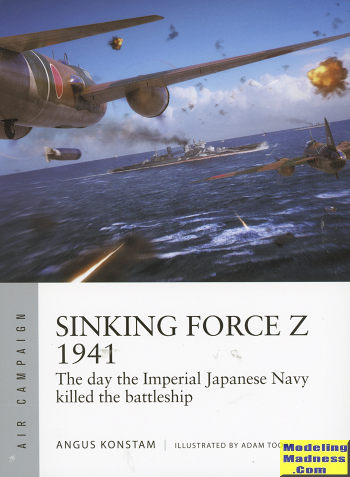 This latest
volume in Osprey's Air Campaign series covers the actions that resulted in the
loss of the Force Z in the first week of the war. Prior to the start of the
Pacific War, the British had sent a small force to Singpore that consisted of
the HMS Prince of Wales and the HMS Repulse. The Prince of Wales was the same
ship that was involved in the sinking of the DKM Bismark and at the time of its
demise was only about a year old. The Repulse was a battlecruiser and was a
veteran of WWI.
This latest
volume in Osprey's Air Campaign series covers the actions that resulted in the
loss of the Force Z in the first week of the war. Prior to the start of the
Pacific War, the British had sent a small force to Singpore that consisted of
the HMS Prince of Wales and the HMS Repulse. The Prince of Wales was the same
ship that was involved in the sinking of the DKM Bismark and at the time of its
demise was only about a year old. The Repulse was a battlecruiser and was a
veteran of WWI.
When the war began, the Japanese seemed to be everywhere in
the southwest Pacific. They had already cowed the Vichy French into allowing
them to have air bases and ports in Indochina and their treatment of Siam was
such that they simply told the government they were moving troops through the
nation during their invasion of Malaya. They also did amphibious landings on the
east coast of that nation and when the British realized what was going on, they
decided to send the two capital ships.
Things moved fairly slowly and it was a day or two before
these two ships along with several destroyers (Force Z) set off for the invasion
grounds. There was a concern about running into submarines and they did not want
to be discovered by aircraft recon flights. Luck was with them as they passed
through the submarine patrol line unscathed. The weather was also poor which
prevented discovery by air. They were seen by a Japanese submarine off in the
distance, but the sub was too slow to keep up with them. However, it was known
that they were at sea. Just not where they were.
On the day they were nearing the Japanese invasion forces
(which by now had already disembarked most of the troops and equipment, the
weather turned against them and they turned around to return to Singapore.
Japanese bomber units in southern Indochina was armed and sent off. Japanese
bombers all had excellent range so a 700-800 mile trip was not impossible.
However, despite being found, the positions given were inaccurate. It was only
when the bombers were nearing the turn-around time that Force Z was
re-discovered.
From here it was fairly inevitable what the outcome would be.
As with a lot in war, it was luck and poor judgement that doomed these ships.
The Admiral in charge loitered around too long before heading back to Singapore.
A chance torpedo hit on the Prince of Wales smashed one of the prop shafts and
mounts, tearing a hole in the underside of the ship and allowing water to rush
up the prop shaft. Water tight integrity was not maintained and ended up
flooding the generator rooms. This doomed the ship. The Repulse made the error
in trying to reach the Prince of Wales to off load crew rather than heading away
and letting the destroyers do that job, and so on.
Of course, there is a lot more to it than what I've put
forward. I'll let the book explain most of that. It was the end of the
battleship as the big dog on the oceans and the rise of the aircraft as the main
maritime weapon. It was also the end of 'big gun' thinking in many navies. The
author has written a lot of ship books and always produces a well researched and
highly readable book. You wouldn't think there would be a lot of photos for
this, and there are not, but those chosen are pretty good ones. It is also nice
that the art work is well done and the maps are easy to understand and help. In
all, another superb book from Osprey and one that I can easily recommend to you.
February 2021
Copyright ModelingMadness.com. All rights reserved.
Thanks to Osprey Publishing for the review book. For more on the complete line of Osprey books and to order
this one, visit
www.ospreypublishing.com
.
If you would like your product reviewed fairly and quickly, please contact
the editor or see other details in the Note to
Contributors.
 This latest
volume in Osprey's Air Campaign series covers the actions that resulted in the
loss of the Force Z in the first week of the war. Prior to the start of the
Pacific War, the British had sent a small force to Singpore that consisted of
the HMS Prince of Wales and the HMS Repulse. The Prince of Wales was the same
ship that was involved in the sinking of the DKM Bismark and at the time of its
demise was only about a year old. The Repulse was a battlecruiser and was a
veteran of WWI.
This latest
volume in Osprey's Air Campaign series covers the actions that resulted in the
loss of the Force Z in the first week of the war. Prior to the start of the
Pacific War, the British had sent a small force to Singpore that consisted of
the HMS Prince of Wales and the HMS Repulse. The Prince of Wales was the same
ship that was involved in the sinking of the DKM Bismark and at the time of its
demise was only about a year old. The Repulse was a battlecruiser and was a
veteran of WWI.